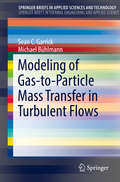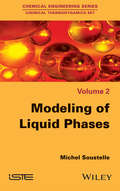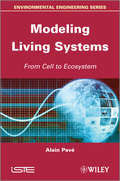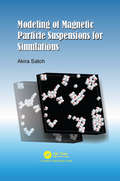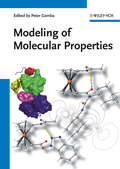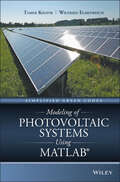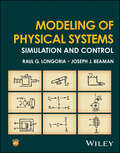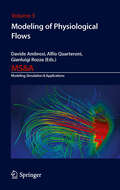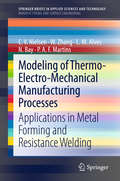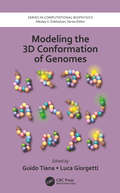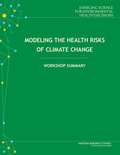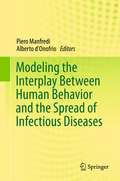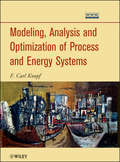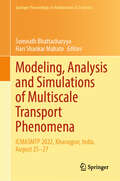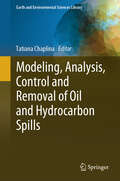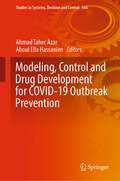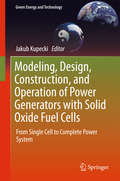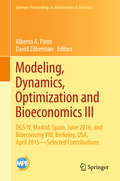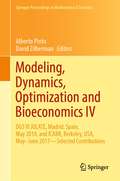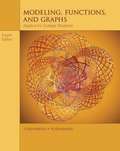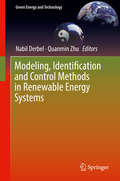- Table View
- List View
Modeling of Gas-to-Particle Mass Transfer in Turbulent Flows
by Sean C. Garrick Michael BühlmannThis Brief focuses on the dispersion of high-porosity particles, their entrainment into the vapor-laden stream, and the condensation of vapor onto the particles. The authors begin with a simple/static problem, focusing on transport within the particle. They go on to consider the high-resolution simulation of particles in a turbulent flow and the time-dependent evolution of the fluid-particle fields. Finally, they examine the more computationally-affordable large-eddy simulation of gas-to-particle mass-transfer. The book ends with a summary and challenges as well as directions for the area.
Modeling of Hydrodynamics and Sediment Transport in the Mekong Delta (IHE Delft PhD Thesis Series)
by Vo Quoc ThanhThis research aims to investigate the prevailing sediment dynamics and the sediment budget in the Mekong Delta by using a process-based model. Understanding sediment dynamics for the Mekong Delta requires high resolution analysis and detailed data, which is a challenge for managers and scientists. This study introduces such an approach and focuses on modeling the entire system with a process-based approach with Delft3D-4 and Delft3D Flexible Mesh (DFM). The first model is used to explore sediment dynamics at the coastal zone. The latter model allows straightforward coupling of 1D and 2D grids, making it suitable for analyzing the complex river and canal network of the Mekong Delta. The validated model suggests that the Mekong Delta receives ~99 Mt/year sediment from the Mekong River. This is much lower than the common estimate of 160 Mt/year. Only about 23% of the modelled total sediment load at Kratie is exported to the sea. The remaining portion is trapped in the rivers and floodplains of the Mekong Delta. The results advance understanding of sediment dynamics and sediment budget in the Mekong Delta. As such the model is an efficient tool to support delta management and planning.
Modeling of Liquid Phases
by Michel SoustelleThis book is part of a set of books which offers advanced students successive characterization tool phases, the study of all types of phase (liquid, gas and solid, pure or multi-component), process engineering, chemical and electrochemical equilibria, and the properties of surfaces and phases of small sizes. Macroscopic and microscopic models are in turn covered with a constant correlation between the two scales. Particular attention has been given to the rigor of mathematical developments. This second volume in the set is devoted to the study of liquid phases.
Modeling of Living Systems: From Cell to Ecosystem
by Alain PavéModeling is now one of the most efficient methodologies in life sciences. From practice to theory, this book develops this approach illustrated by many examples; general concepts and the current state of the art are also presented and discussed. An historical and general introduction informs the reader how mathematics and formal tools are used to solve biological problems at all levels of the organization of life. The core of this book explains how this is done, based on practical examples coming, for the most part, from the author’s personal experience. In most cases, data are included so that the reader can follow the reasoning process and even reproduce calculus. The final chapter is devoted to essential concepts and current developments. The main mathematical tools are presented in an appendix to the book and are written in an adapted language readable by scientists, professionals or students, with a basic knowledge of mathematics.
Modeling of Magnetic Particle Suspensions for Simulations
by Akira SatohThe main objective of the book is to highlight the modeling of magnetic particles with different shapes and magnetic properties, to provide graduate students and young researchers information on the theoretical aspects and actual techniques for the treatment of magnetic particles in particle-based simulations. In simulation, we focus on the Monte Carlo, molecular dynamics, Brownian dynamics, lattice Boltzmann and stochastic rotation dynamics (multi-particle collision dynamics) methods. The latter two simulation methods can simulate both the particle motion and the ambient flow field simultaneously. In general, specialized knowledge can only be obtained in an effective manner under the supervision of an expert. The present book is written to play such a role for readers who wish to develop the skill of modeling magnetic particles and develop a computer simulation program using their own ability. This book is therefore a self-learning book for graduate students and young researchers. Armed with this knowledge, readers are expected to be able to sufficiently enhance their skill for tackling any challenging problems they may encounter in future.
Modeling of Molecular Properties
by Peter CombaMolecular modeling encompasses applied theoretical approaches and computational techniques to model structures and properties of molecular compounds and materials in order to predict and / or interpret their properties. The modeling covered in this book ranges from methods for small chemical to large biological molecules and materials. With its comprehensive coverage of important research fields in molecular and materials science, this is a must-have for all organic, inorganic and biochemists as well as materials scientists interested in applied theoretical and computational chemistry. The 28 chapters, written by an international group of experienced theoretically oriented chemists, are grouped into four parts: Theory and Concepts; Applications in Homogeneous Catalysis; Applications in Pharmaceutical and Biological Chemistry; and Applications in Main Group, Organic and Organometallic Chemistry. The various chapters include concept papers, tutorials, and research reports.
Modeling of Photovoltaic Systems Using MATLAB: Simplified Green Codes
by Wilfried Elmenreich Tamer KhatibProvides simplified MATLAB codes for analysis of photovoltaic systems, describes the model of the whole photovoltaic power system, and shows readers how to build these models line by line. This book presents simplified coded models for photovoltaic (PV) based systems using MATLAB to help readers understand the dynamic behavior of these systems. Through the use of MATLAB, the reader has the ability to modify system configuration, parameters and optimization criteria. Topics covered include energy sources, storage, and power electronic devices. This book contains six chapters that cover systems' components from the solar source to the end-user. Chapter 1 discusses modelling of the solar source, and Chapter 2 discusses modelling of the photovoltaic source. Chapter 3 focuses on modeling of PV systems' power electronic features and auxiliary power sources. Modeling of PV systems' energy flow is examined in Chapter 4, while Chapter 5 discusses PV systems in electrical power systems. Chapter 6 presents an application of PV system models in systems' size optimization. Common control methodologies applied to these systems are also modeled. * Covers the basic models of the whole photovoltaic power system, enabling the reader modify the models to provide different sizing and control methodologies * Examines auxiliary components to photovoltaic systems, including wind turbines, diesel generators, and pumps * Contains examples, drills and codes Modeling of Photovoltaic Systems Using MATLAB: Simplified Green Codes is a reference forresearchers, students, and engineers who work in the field of renewable energy, and specifically in photovoltaic systems. Tamer Khatib is an assistant professor in the Energy Engineering and Environment Department at An-Najah National University, Nablus, Palestine. He received his Ph.D. from National University of Malaysia, Malaysia. Khatib is a Senior Member of IEEE, a member of IEEE Power and Energy Society, and a member of The International Solar Energy Society. Wilfried Elmenreich is a professor of Smart Grids at the Alpen-Adria-Universität in Klagenfurt, Austria. He received his Ph.D. from Vienna University of Technology, Austria. His research projects also affiliate him with the Lakeside Labs research cluster in Klagenfurt. Elmenreich is a Senior Member of IEEE and counselor of Klagenfurt's IEEE student branch.
Modeling of Physical Systems: Simulation and Control
by Raul G. Longoria Joseph J. BeamanIntroductory text on nonlinear and continuous-time dynamic systems using bond graph methodology to enable readers to develop and apply physical system models Through an integrated and uniform approach to system modeling, analysis, and control, Modeling of Physical Systems uses realistic examples to link empirical, analytical, and numerical approaches and provide readers with the essential foundation needed to move towards more advanced topics in systems engineering. Rather than use only a linear modeling methodology, this book also incorporates nonlinear modeling approaches. The authors approach the topic using bond graph methodology, a well-known and highly effective method for the modeling and analysis of multi-energy domain systems at the physical level. With a strong focus on fundamentals, this book begins by reviewing core topics which engineering students will have been exposed to in their first two years of study. It then expands into introducing systematic model development using a bond graph approach. Later chapters expand on the fundamental understanding of systems, with insights regarding how to make decisions on what to model and how much complexity is needed for a particular problem. Written by two professors with nearly a century of combined research and industry experience, Modeling of Physical Systems explores topics including: Basic Kirchoff systems, covering mechanical translation and rotation, electrical, hydraulic, and thermal systems, and ideal couplersA complete introduction to bond graph methods and their application to practical engineering system modelingComputer-based analysis and simulation, covering algebraic analysis of system equation and semi-analytical analysis for linear system responseMultiport fields, distributed systems and transmission elements, covering heat and magnetism power lines and wave propagation modeling with W- and H-LinesSignal and power in measurement and control, covering derivative control and effect of feedback Modeling of Physical Systems is an essential learning resource for mechanical, mechatronics, and aerospace engineering students at the graduate and senior graduate level. The text is also valuable for professional engineers and researchers, controls engineers, and computer scientists seeking an understanding of engineering system modeling.
Modeling of Physiological Flows
by Gianluigi Rozza Alfio Quarteroni Davide AmbrosiThis book offers a mathematical update of the state of the art of the research in the field of mathematical and numerical models of the circulatory system. It is structured into different chapters, written by outstanding experts in the field. Many fundamental issues are considered, such as: the mathematical representation of vascular geometries extracted from medical images, modelling blood rheology and the complex multilayer structure of the vascular tissue, and its possible pathologies, the mechanical and chemical interaction between blood and vascular walls, and the different scales coupling local and systemic dynamics. All of these topics introduce challenging mathematical and numerical problems, demanding for advanced analysis and efficient simulation techniques, and pay constant attention to applications of relevant clinical interest. This book is addressed to graduate students and researchers in the field of bioengineering, applied mathematics and medicine, wishing to engage themselves in the fascinating task of modeling the cardiovascular system or, more broadly, physiological flows.
Modeling of Processes and Reactors for Upgrading of Heavy Petroleum (ISSN)
by Jorge AncheytaThe worldwide petroleum industry is facing a dilemma: the production level of heavy petroleum is higher than that of light petroleum. Heavy crude oils possess high amounts of impurities (sulfur, nitrogen, metals, and asphaltenes), as well as a high yield of residue with consequent low production of valuable distillates (gasoline and diesel). These
Modeling of Thermo-Electro-Mechanical Manufacturing Processes
by L. M. Alves N. Bay C. V. Nielsen Niels Bay W. ZhangModeling of Thermo-Electro-Mechanical Manufacturing Processes with Applications in Metal Forming and Resistance Welding provides readers with a basic understanding of the fundamental ingredients in plasticity, heat transfer and electricity that are necessary to develop and proper utilize computer programs based on the finite element flow formulation. Computer implementation of a wide range of theoretical and numerical subjects related to mesh generation, contact algorithms, elasticity, anisotropic constitutive equations, solution procedures and parallelization of equation solvers is comprehensively described. Illustrated and enriched with selected examples obtained from industrial applications, Modeling of Thermo-Electro-Mechanical Manufacturing Processes with Applications in Metal Forming and Resistance Welding works to diminish the gap between the developers of finite element computer programs and the professional engineers with expertise in industrial joining technologies by metal forming and resistance welding.
Modeling the 3D Conformation of Genomes (Series in Computational Biophysics)
by Guido Tiana Luca GiorgettiThis book provides a timely summary of physical modeling approaches applied to biological datasets that describe conformational properties of chromosomes in the cell nucleus. Chapters explain how to convert raw experimental data into 3D conformations, and how to use models to better understand biophysical mechanisms that control chromosome conformation. The coverage ranges from introductory chapters to modeling aspects related to polymer physics, and data-driven models for genomic domains, the entire human genome, epigenome folding, chromosome structure and dynamics, and predicting 3D genome structure.
Modeling the Electrochemo-poromechanics of Ionic Polymer Metal Composites and Cell Clusters (Springer Theses)
by Alessandro LeronniThis book presents a novel continuum finite deformation framework addressing the complex interactions among electrostatics, species transport, and mechanics in solid networks immersed in a fluid phase of solvent and ions. Grounded on cutting-edge multiphysics theories for soft active materials, the proposed model is primarily applied to ionic polymer metal composites (IPMCs). First, the influence of shear deformation on the IPMC response is analyzed through semi-analytical solutions obtained via the method of matched asymptotic expansions. Second, the novel electrochemo-poromechanical theory is used to predict the curvature relaxation and electric discharge that are observed in IPMC actuation and sensing, respectively, under a sustained stimulus. This newly formulated theory is, in turn, applied to biological cell clusters. Here, important mechanical considerations are integrated into classical bioelectrical models, thus offering novel insights into the interplay of mechanical and electrical signaling in the coordination of developmental processes.
Modeling the Fate of Chemicals in Products (Springer Theses)
by Li LiThis thesis provides a novel methodological basis for mechanistically understanding the dynamics of chemicals in products (CiPs) in the anthroposphere and physical environment and establishes a modeling continuum from production of a chemical to its concentrations in various environmental compartments. Using this framework, the thesis investigates how CiPs are transported and transformed and how they accumulate in the global environment. Furthermore, it identifies the measures needed to minimize their adverse effects on the environment and human society. It serves as an invaluable, interdisciplinary reference resource for industrial ecologists, environmental chemists and decision-makers involved in environmentally sound management of CiPs and associated waste.
Modeling the Health Risks of Climate Change: Workshop Summary
by Kellyn BettsClimate change poses risks to human health and well-being through shifting weather patterns, increases in frequency and intensity of heat waves and other extreme weather events, rising sea levels, ocean acidification, and other environmental effects. Those risks occur against a backdrop of changing socioeconomic conditions, medical technology, population demographics, environmental conditions, and other factors that are important in determining health. Models of health risks that reflect how health determinants and climate changes vary in time and space are needed so that we can inform adaptation efforts and reduce or prevent adverse health effects. Robust health risk models could also help to inform national and international discussions about climate policies and the economic consequences of action and inaction. Interest in resolving some of the challenges facing health effects modelers and health scientists led the National Research Council's Standing Committee on Emerging Science for Environmental Health Decisions to hold a workshop on November 3-4, 2014, in Washington, DC, to explore new approaches to modeling the human health risks of climate change. Throughout the workshop, the discussions highlighted examples of current application of models, research gaps, lessons learned, and potential next steps to improve modeling of health risks associated with climate change. "Modeling the Health Risks of Climate Change" summarizes the presentation and discussion of the workshop.
Modeling the Interplay Between Human Behavior and the Spread of Infectious Diseases
by Alberto D'Onofrio Piero ManfrediThis volume summarizes the state-of-the-art in the fast growing research area of modeling the influence of information-driven human behavior on the spread and control of infectious diseases. In particular, it features the two main and inter-related "core" topics: behavioral changes in response to global threats, for example, pandemic influenza, and the pseudo-rational opposition to vaccines. In order to make realistic predictions, modelers need to go beyond classical mathematical epidemiology to take these dynamic effects into account. With contributions from experts in this field, the book fills a void in the literature. It goes beyond classical texts, yet preserves the rationale of many of them by sticking to the underlying biology without compromising on scientific rigor. Epidemiologists, theoretical biologists, biophysicists, applied mathematicians, and PhD students will benefit from this book. However, it is also written for Public Health professionals interested in understanding models, and to advanced undergraduate students, since it only requires a working knowledge of mathematical epidemiology.
Modeling, Analysis and Optimization of Process and Energy Systems
by F. Carl KnopfEnergy costs impact the profitability of virtually all industrial processes. Stressing how plants use power, and how that power is actually generated, this book provides a clear and simple way to understand the energy usage in various processes, as well as methods for optimizing these processes using practical hands-on simulations and a unique approach that details solved problems utilizing actual plant data. Invaluable information offers a complete energy-saving approach essential for both the chemical and mechanical engineering curricula, as well as for practicing engineers.
Modeling, Analysis and Simulations of Multiscale Transport Phenomena: ICMASMTP 2022, Kharagpur, India, August 25–27 (Springer Proceedings in Mathematics & Statistics #491)
by Somnath Bhattacharyya Hari Shankar MahatoThis volume contains selected chapters on topics presented at the International Conference on Modeling, Analysis and Simulations of Multiscale Transport Phenomena (ICMASMTP 2022), held at the Department of Mathematics, Indian Institute of Technology Kharagpur, West Bengal, India, from 22–25 August 2022. It contains chapters on applications of FLOW THROUGH POROUS MEDIA, diffusion–reaction equations, fluid dynamics, multi-scale analysis, electrokinetic transport processes, microfluidics modelling, numerical analysis, and related topics. Contributors are academicians, experts and researchers in various disciplines of applied mathematics, numerical analysis and scientific computation, having applications in physics, engineering, chemistry, biology and medical science.
Modeling, Analysis, Control and Removal of Oil and Hydrocarbon Spills (Earth and Environmental Sciences Library)
by Tatiana ChaplinaA large number of scientific works are devoted to the study and modeling of accidental oil spills. However, there is no single approach to the description of processes and a generally accepted system of models. An additional fundamental difficulty is the impossibility of conducting full-fledged full-scale experimental studies, which makes it difficult to verify the adequacy and accuracy of oil spill models. Our book is devoted to the problems of experimental investigation and theoretical description of spills, as well as the practical removal of various petroleum products from the water surface and ice. It provides an overview of the most well-known theoretical models of the process of spreading oil stains on the water surface. Also, in the relevant sections, an original spreading model based on an energy approach is proposed and analyzed. The results of new experimental studies of the dynamics of the process for various hydrocarbons on water, including variations in its temperatureand salinity, are presented. In the following chapters, a theoretical description of oil spreading on the upper and lower surfaces of floating ice is proposed, modeling phenomena in the Arctic and subarctic zones of the world ocean. New experimental data on the spreading of petroleum products on the ice surface are presented. The final part provides a brief overview of the existing most used and promising methods for removing of hydrocarbons from the water surface. New original constructive solutions to this problem are proposed, the technical characteristics of which have received theoretical justification and experimental confirmation.
Modeling, Control and Drug Development for COVID-19 Outbreak Prevention (Studies in Systems, Decision and Control #366)
by Ahmad Taher Azar Aboul Ella HassanienThis book is well-structured book which consists of 31 full chapters. The book chapters' deal with the recent research problems in the areas of modeling, control and drug development, and it presents various techniques of COVID-19 outbreak prevention modeling. The book also concentrates on computational simulations that may help speed up the development of drugs to counter the novel coronavirus responsible for COVID-19.
Modeling, Design, Construction, and Operation of Power Generators with Solid Oxide Fuel Cells: From Single Cell To Complete Power System (Green Energy And Technology)
by Jakub KupeckiThe book summarizes the current state of the solid oxide fuel cell (SOFC) technology in power generation applications. It describes the single cells, SOFC stacks, micro-combined heat and power systems, large-scale stationary power generators and polygeneration units. The principles of modeling, simulation and controls of power systems with solid oxide fuel cells are presented and discussed. Authors provide theoretical background of the technology followed by the essential insights into the integrated power systems. Selected aspects of the design, construction and operation of power units in range from single kilowatts to hundreds of kilowatts are presented. Finally, the book reports the selected studies on prototype systems which have been constructed in Europe.The book discusses the theoretical and practical aspects of operation of power generators with solid oxide fuel cells including fabrication of cells, design of stacks, system modeling, simulation of stationary and non-stationary operation of systems, fuel preparation and controls.
Modeling, Dynamics, Optimization and Bioeconomics III: Contributions From Dgs Iii And The 7th Bioeconomy Conference 2014 (Springer Proceedings in Mathematics & Statistics #195)
by David Zilberman Alberto A. PintoThe research and review papers presented in this volume provide an overview of the main issues, findings, and open questions in cutting-edge research on the fields of modeling, optimization and dynamics and their applications to biology, economics, energy, finance, industry, physics and psychology. Given the scientific relevance of the innovative applications and emerging issues they address, the contributions to this volume, written by some of the world’s leading experts in mathematics, economics and other applied sciences, will be seminal to future research developments and will spark future works and collaborations. The majority of the papers presented in this volume were written by participants of the 4th International Conference on Dynamics, Games and Science: Decision Models in a Complex Economy (DGS IV), held at the National Distance Education University (UNED) in Madrid, Spain in June 2016 and of the 8th Berkeley Bioeconomy Conference: The Future of Biofuels, held at the UC Berkeley Alumni House in April 2015.
Modeling, Dynamics, Optimization and Bioeconomics IV: DGS VI JOLATE, Madrid, Spain, May 2018, and ICABR, Berkeley, USA, May–June 2017—Selected Contributions (Springer Proceedings in Mathematics & Statistics #365)
by David Zilberman Alberto PintoThis book, following the three published volumes of the book, provides the main purpose to collect research papers and review papers to provide an overview of the main issues, results, and open questions in the cutting-edge research on the fields of modeling, optimization, and dynamics and their applications to biology, economy, energy, industry, physics, psychology and finance. Assuming the scientific relevance of the presenting innovative applications as well as merging issues in these areas, the purpose of this book is to collect papers of the world experts in mathematics, economics, and other applied sciences that is seminal to the future research developments. The majority of the papers presented in this book is authored by the participants in The Joint Meeting 6th International Conference on Dynamics, Games, and Science – DGSVI – JOLATE and in the 21st ICABR Conference. The scientific scope of the conferences is focused on the fields of modeling, optimization, and dynamics and their applications to biology, economy, energy, industry, physics, psychology, and finance. Assuming the scientific relevance of the presenting innovative applications as well as merging issues in these areas, the purpose of the conference is to bring together some of the world experts in mathematics, economics, and other applied sciences that reinforce ongoing projects and establish future works and collaborations.
Modeling, Functions, and Graphs: Algebra for College Students
by Katherine Yoshiwara Bruce YoshiwaraThe Fourth Edition of Yoshiwara and Yoshiwara's MODELING, FUNCTIONS, AND GRAPHS: ALGEBRA FOR COLLEGE STUDENTS includes content found in a typical algebra course, along with introductions to curve-fitting and display of data. Yoshiwara and Yoshiwara focus on three core themes throughout their textbook: Modeling, Functions, and Graphs. In their work of modeling and functions, the authors utilize the Rule of Four, which is that all problems should be considered using algebraic, numerical, graphical, and verbal methods. The authors motivate students to acquire the skills and techniques of algebra by placing them in the context of simple applications that use real-life data.
Modeling, Identification and Control Methods in Renewable Energy Systems (Green Energy and Technology)
by Quanmin Zhu Nabil DerbelMost of the research and experiments in the fields of modeling and control systems have spent significant efforts to find rules from various complicated phenomena by principles, observations, measured data, logic derivations. The rules are normally summarized as concise and quantitative expressions or “models”. “Identification” provides mechanisms to establish the models and “control” provides mechanisms to improve system performances.This book reflects the relevant studies and applications in the area of renewable energies, with the latest research from interdisciplinary theoretical studies, computational algorithm development to exemplary applications. It discusses how modeling and control methods such as recurrent neural network, Pitch Angle Control, Fuzzy control, Sliding Mode Control and others are used in renewable systems. It covers topics as photovoltaic systems, wind turbines, maximum power point tracking, batteries for renewable energies, solar energy, thermal energy and so on. This book is edited and written by leading experts in the field and offers an ideal reference guide for researchers and engineers in the fields of electrical/electronic engineering, control system and energy.
